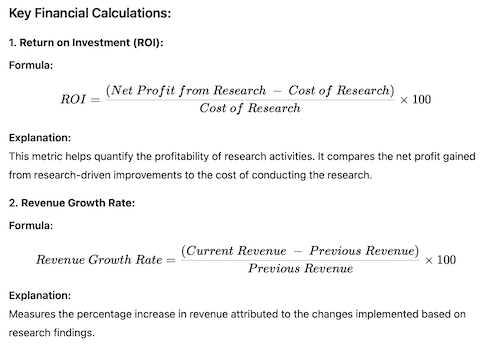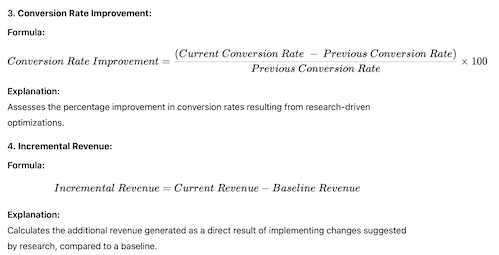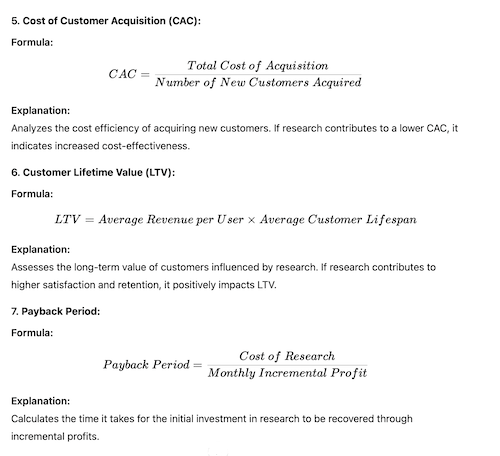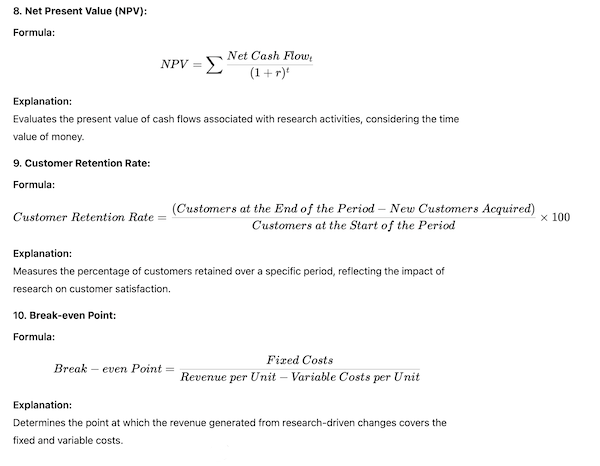Demonstrating Return on Investment (ROI) for research on products involves showcasing the value and impact of the research activities on the overall success of the products.
Here are some steps you can take to demonstrate research ROI for products:
Define Clear Objectives
Clearly define the objectives of your research. What specific questions or challenges are you trying to address? Align your research goals with the overall product strategy.
Measure Key Performance Indicators (KPIs)
Identify and measure relevant KPIs that directly relate to your research objectives. These could include metrics like increased product sales, customer satisfaction, user engagement, or time-to-market for new features.
Benchmark Against Baseline Metrics
Establish baseline metrics before conducting the research. This provides a reference point for measuring the impact of the research. Compare post-research metrics to the baseline to highlight improvements.
Customer Feedback and Satisfaction
If your research involves gathering customer feedback, use customer satisfaction scores and qualitative feedback to showcase how the research has positively influenced the product’s appeal to users.
Time and Cost Savings
Demonstrate any time or cost savings achieved as a result of the research. For example, if the research helped identify and address issues early in the product development process, it could save time and resources.
Incorporate Research Findings into Product Development
Show how research findings were directly incorporated into the product development process. Highlight specific features, improvements, or changes that were a direct result of the research.
User Adoption and Engagement
Measure and showcase increased user adoption or engagement resulting from the changes implemented based on research findings. This could include higher usage rates, longer session durations, or increased retention.
Competitive Advantage
If your research provides insights that give your product a competitive edge, emphasize this advantage. Showcase how your product stands out in the market due to the informed decisions made through research.
Case Studies and Success Stories
Develop case studies or success stories that narrate the journey
from research to positive outcomes. Use real-world examples to illustrate the impact of research on product success.
Communication and Reporting
Effectively communicate your findings to key stakeholders. Use clear and concise reports or presentations to convey the value of the research in terms that resonate with your audience.
By combining quantitative and qualitative data, and by aligning research activities with key business goals, you can effectively demonstrate the ROI of research for products.
Revenue and Conversion as Key Performance Indicators (KPIs)
Revenue and conversion are critical Key Performance Indicators (KPIs) when it comes to demonstrating the impact of research on product success. Here’s how you can tie research efforts to these financial metrics:
Attribution Modeling
Use attribution modeling to link specific product improvements or features back to the revenue generated. This helps in attributing revenue to the impact of research findings. For example, if a new feature was implemented based on research, track how it contributes to the overall conversion funnel.
A/B Testing
Implement A/B testing to compare the performance of the product with and without the changes suggested by research. Monitor conversion rates and revenue generated from each variant to assess the direct impact of research-driven changes.
Funnel Analysis
Analyze the sales or conversion funnel to identify points where users may drop off. If research helps in optimizing certain steps in the funnel, monitor how these optimizations lead to increased conversions and revenue.
Customer Segmentation
Segment your customer base based on research findings. Tailor marketing strategies or product offerings to different segments and measure the impact on conversion rates and revenue for each segment.
Lifetime Value (LTV)
Assess the impact of research on customer lifetime value. If the research contributes to higher customer satisfaction and retention, it can positively affect the long-term revenue generated by each customer.
Cart Abandonment Reduction
If your research addresses issues related to cart abandonment, measure the reduction in abandonment rates and the subsequent impact on revenue. Identify how changes based on research encourage users to complete their transactions.
Product Performance Metrics
Track how changes influenced by research impact the performance of specific products or services. If certain products see increased sales or higher conversion rates due to research-driven improvements, highlight these successes.
Cross-Sell and Upsell Opportunities
Explore how research findings can be leveraged to identify new cross-sell or upsell opportunities. Measure the revenue generated from these additional sales facilitated by the insights gained through research.
Time-to-Market
Consider the time-to-market for new features or products influenced by research. If faster implementation leads to quicker revenue generation, emphasize how research accelerates product development cycles.
Customer Acquisition Costs (CAC)
Assess the impact of research on reducing customer acquisition costs. If research helps in targeting the right audience or improving marketing efficiency, it can contribute to a lower CAC and higher ROI.
When presenting these metrics, make sure to clearly articulate the connection between the research activities and the observed improvements in revenue and conversion. This will help stakeholders understand the tangible impact of research on the financial success of the product.
Financial Calculations
To demonstrate the financial impact of research efforts on products, you can use various financial calculations and metrics.
Here are some key financial calculations to consider:












